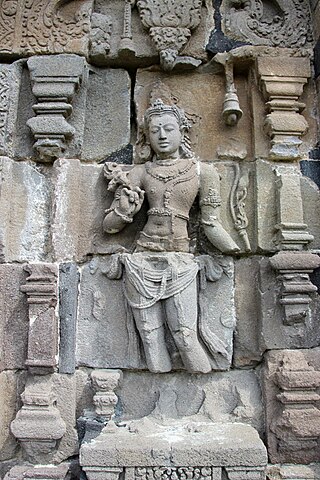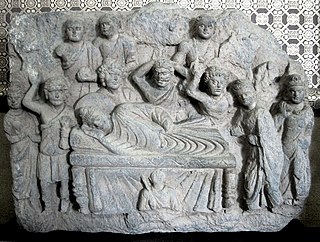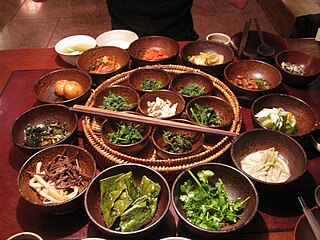
In Buddhism, a bodhisattva ( BOH-dee-SUT-və; or bodhisatva is a person who is on the path towards bodhi or Buddhahood.

The Noble Eightfold Path or Eight Right Paths is an early summary of the path of Buddhist practices leading to liberation from samsara, the painful cycle of rebirth, in the form of nirvana.

The five precepts or five rules of training is the most important system of morality for Buddhist lay people. They constitute the basic code of ethics to be respected by lay followers of Buddhism. The precepts are commitments to abstain from killing living beings, stealing, sexual misconduct, lying and intoxication. Within the Buddhist doctrine, they are meant to develop mind and character to make progress on the path to enlightenment. They are sometimes referred to as the Śrāvakayāna precepts in the Mahāyāna tradition, contrasting them with the bodhisattva precepts. The five precepts form the basis of several parts of Buddhist doctrine, both lay and monastic. With regard to their fundamental role in Buddhist ethics, they have been compared with the ten commandments in Abrahamic religions or the ethical codes of Confucianism. The precepts have been connected with utilitarianist, deontological and virtue approaches to ethics, though by 2017, such categorization by western terminology had mostly been abandoned by scholars. The precepts have been compared with human rights because of their universal nature, and some scholars argue they can complement the concept of human rights.

Sangha is a Sanskrit word used in many Indian languages, including Pali which means "association", "assembly", "company" or "community"; In these languages, sangha is frequently used as a surname. In a political context, it was historically used to denote a governing assembly in a republic or a kingdom, and for a long time, it has been used by religious associations, including Buddhists, Jains and Sikhs. Given this history, some Buddhists have stated that the tradition of the sangha represents humanity's oldest surviving democratic institution.
Theravāda is the most commonly accepted name of Buddhism's oldest existing school. The school's adherents, termed Theravādins, have preserved their version of Gautama Buddha's teaching or Buddha Dhamma in the Pāli Canon for over two millennia.

In Buddhism, Buddha, "awakened one", is a title for those who are spiritually awake or enlightened, and have thus attained the supreme religious goal of Buddhism, variously described as nirvana, awakening (bodhi) and liberation (vimutti). A Buddha is also someone who has fully understood the Dharma, the true nature of things or the universal law. Buddhahood is the condition and state of a buddha. This highest spiritual state of being is also termed sammā-sambodhi. This state is interpreted in many different ways in the various schools of Buddhism.

Buddhist texts are religious texts that belong to, or are associated with, Buddhism and its traditions. There is no single textual collection for all of Buddhism. Instead, there are three main Buddhist Canons: the Pāli Canon of the Theravāda tradition, the Chinese Buddhist Canon used in East Asian Buddhist tradition, and the Tibetan Buddhist Canon used in Indo-Tibetan Buddhism.

In Buddhism, parinirvana is commonly used to refer to nirvana-after-death, which occurs upon the death of someone who has attained nirvana during their lifetime. It implies a release from Saṃsāra, karma and rebirth as well as the dissolution of the skandhas.
A Buddhist chant is a form of musical verse or incantation, in some ways analogous to religious recitations of other faiths.
Buddhist eschatology, like many facets of modern Buddhist practice and belief, came into existence during its development in China, and, through the blending of Buddhist cosmological understanding and Daoist eschatological views, created a complex canon of apocalyptic beliefs. These beliefs, although not entirely part of orthodox Buddhism, form an important collection of Chinese Buddhist traditions which bridge the gap between the monastic order and local beliefs of Imperial China.

The desire realm is one of the trailokya or three realms in Buddhist cosmology into which a being caught in saṃsāra may be reborn. The other two are the Form Realm, and the Formless Realm.
A Dharma name or Dhamma name is a new name acquired during both lay and monastic Buddhist initiation rituals in Mahayana Buddhism and monastic ordination in Theravada Buddhism. The name is traditionally given by a Buddhist monastic, and is given to newly ordained monks, nuns and laity. Dharma names are considered aspirational, not descriptive.
The brahmavihārā are a series of four Buddhist virtues and the meditation practices made to cultivate them. They are also known as the four immeasurables or four infinite minds. The brahmavihārā are:
- loving-kindness or benevolence
- compassion
- empathetic joy
- equanimity
Buddhism, also known as Buddha Dharma, and Dharmavinaya, is an Indian religion or philosophical tradition based on teachings attributed to the Buddha. It originated in the eastern Gangetic plain as a śramaṇa–movement in the 5th century BCE, and gradually spread throughout much of Asia via the Silk Road. It is the world's fourth-largest religion, with over 520 million followers (Buddhists) who comprise seven percent of the global population.

Buddhist vegetarianism is the practice of vegetarianism by significant portions of Mahayana Buddhist monks and nuns and some Buddhists of other sects. In Buddhism, the views on vegetarianism vary between different schools of thought. The Mahayana schools generally recommend a vegetarian diet because they claimed Gautama Buddha set forth in some of the sutras that his followers must not eat the flesh of any sentient being.

Buddhist ethics are traditionally based on what Buddhists view as the enlightened perspective of the Buddha. The term for ethics or morality used in Buddhism is Śīla or sīla (Pāli). Śīla in Buddhism is one of three sections of the Noble Eightfold Path, and is a code of conduct that embraces a commitment to harmony and self-restraint with the principal motivation being nonviolence, or freedom from causing harm. It has been variously described as virtue, moral discipline and precept.

Women in Buddhism is a topic that can be approached from varied perspectives including those of theology, history, anthropology, and feminism. Topical interests include the theological status of women, the treatment of women in Buddhist societies at home and in public, the history of women in Buddhism, and a comparison of the experiences of women across different forms of Buddhism. As in other religions, the experiences of Buddhist women have varied considerably.
The Bodhisattva Precepts are a set of ethical trainings (śīla) used in Mahāyāna Buddhism to advance a practitioner along the path to becoming a bodhisattva. Traditionally, monastics observed the basic moral code in Buddhism, the prātimokṣa, but in the Mahāyāna tradition, monks may observe the Bodhisattva Precepts as well. The Bodhisattva Precepts are associated with the bodhisattva vow to save all beings and with bodhicitta.

Buddhism is a religion and philosophy encompassing a variety of traditions, beliefs and practices, largely based on teachings attributed to Siddhartha Gautama, commonly known as the Buddha, "the awakened one".












